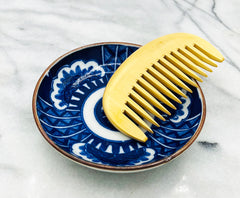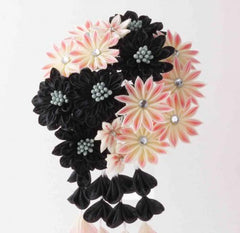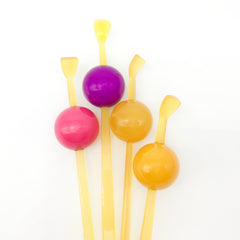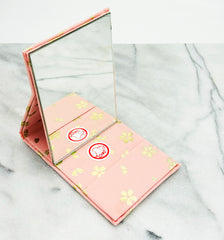MATERIALS
FLOWER: Silk 100% + Metal stick attached
Handmade in Japan

Welcome the much-anticipated return of Chidoriya Original Tsuge Boxwood Combs—an essential addition for hair enthusiasts! Meticulously crafted from Tsuge Boxwood and handmade in Japan, these combs redefine precision in parting and sectioning, instantly elevating your style to sleek sophisticati...
MORE INFOOriginal Kimono Clutch Bags are expertly crafted in the historic city of Kyoto, Japan, and can also be found at the luxurious Hyatt Regency hotel. With dimensions measuring W8.5 inches by L4 inches, these stylish and functional handcrafted bags showcase the skill and tradition of Kyoto's arti...
MORE INFO
Elevate your style with the SukiSuki KISS! Kanzashi Hair Pin, inspired by the sophisticated art of traditional Japanese hairstyles. Crafted with intricate details, this pin adds an exclusive touch of elegance to any look. The term "kanzashi" is often used to describe the traditional folded clo...
MORE INFO
Chidoriya original cosmetic pouches are completely handmade from scratch, using a unique hand-dyed, hand-painted technique on pure silk kimono called "Rouketsuzome". These cosmetic pouches are handmade by a very talented artisan in Kyoto, Japan. Size: 10.5"W x 7"L x 1"D LIMITED EDITION: If y...
MORE INFO
Original kimono clutch bags from Kyoto Chidoriya. If you purchase any of these silk kimono clutch bags, you will also receive one of our lip balms (Yuzu or Hinoki) and a booklet of the Face paper (30sheets) - The set is filled with $106.00 worth. Please take this opportunity to order this bag! S...
MORE INFO
NENE KANZASHI offers a sophisticated and practical way to experience the traditional Japanese hair ornament. Certain models even include self-defense capabilities. In English-speaking countries, "kanzashi" is often linked to the cloth flowers and tsumami kanzashi technique. MATERIALS Special...
MORE INFO
Playing Card Obidome! An obidome (normally spelled as one word and pronounced "oh-bee-doe-may") is an ornamental trim worn by Japanese women with their kimono attire. Prior to the beginning of the 17th century, both women and men wore a plain, rope-like cord to secure the kimono at the waist. T...
MORE INFO
This "Tama-Kanzashi" style has been loving its beauty of simplicity.Which color are you?! Kanzashi story Kanzashi (簪) are hair ornaments used in traditional Japanese hairstyles. Some models may have been modified for self-defense.In the English-speaking world, the term "kanzashi" is sometimes a...
MORE INFOThis Tama kanzashi is a timeless, elegant accessory commonly worn by Maiko in Japan, often paired with ornate hair sticks. Derived from traditional Japanese hairstyles, kanzashi (簪) are functional hair ornaments that can also serve as self-defense tools. In English-speaking countries, kanzashi ...
MORE INFO
The CHIDORI-chan KANZASHI hair sticks are designed after the traditional Japanese Kanzashi (簪) hair ornaments. These ornaments have a long history and were originally used for traditional Japanese hairstyles. Some models may have even been altered for self-defense purposes. In Western countries,...
MORE INFO
This particular Maiko Hana kanzashi hair stick, originating from Kyoto, Japan, is one of our most beloved pieces. It's versatile and adds beauty to hair of any color. The "HABUTAE" manufacturing process involves "dying" the fabric with vivid shades for the Shichigosan ("seven-five-three" festiva...
MORE INFO
This CHIDORI KANZASHI hair pin is handcrafted and embodies a rich Japanese tradition. Its distinct design, originally utilized for self-defense, has now evolved to also include the iconic tsumami kanzashi folded cloth flowers. Manufactured in Japan, this pin offers both utility and style for va...
MORE INFO
This versatile piece can serve as both a brooch and a hair accessory. The word Haikara originated from the Meiji period and is a hybrid of Japanese and English, stemming from the phrase “high collar.” (Originally written as haikarā, ハイカラー.) While it can be interpreted as "fashionably Westernize...
MORE INFO
Elevate your hair game with LOVER'S ROCK MAIKO HANA KANZASHI HAIR STICK. This versatile accessory complements both traditional kimonos and modern dresses. Coordinate it with other kanzashi hair sticks for a unique look. The intricate manufacturing process involves dying the fabrics, applying gl...
MORE INFO
SIMPLE, COOL & CHIC...BLACK & WHITE are the BEST! Kanzashi (簪) are hair ornaments used in traditional Japanese hairstyles. Some models may have been modified for self-defense.In the English-speaking world, the term "kanzashi" is sometimes applied to the folded cloth flowers that traditi...
MORE INFO
The ROCK STEADY HANA KANZASHI HAIR STICK offers a unique blend of traditional Japanese hairstyling and self-defense features. These hair ornaments, known as kanzashi (簪), have been used for centuries and can also be adorned with tsumami kanzashi folded cloth flowers. Additionally, they are cra...
MORE INFO
LIMITED EDITION Kanzashi (簪) are hair ornaments used in traditional Japanese hairstyles. Some models may have been modified for self-defense.In the English-speaking world, the term "kanzashi" is sometimes applied to the folded cloth flowers that traditionally adorned tsumami kanzashi or to the te...
MORE INFO
These hair sticks, known as "Tama-Kanzashi," are highly praised for their elegant simplicity and candy-like appearance. Want to know more about their history and craftsmanship? Discover the Kanzashi story. In Japan, they were originally used as decorative hair ornaments, but some models may hav...
MORE INFO
These Chidoriya Rocks original T-shirts are made from organic cotton and were designed by Kyoto chidoriya. They are available in sizes S, M, L, and XL, but please note that they tend to run smaller than American sizes. INGREDIENTS ORGANIC COTTON 100%Made in JAPAN HOW TO USE Wear it we...
MORE INFO
ORIGINAL KIMONO STAND MIRROR MATERIALS Chirimen kimono fabrics on gold painting (Sakura)Size of Mirror (Inside): 5-inch L x 3,3/8-inch W Handmade in Japan HOW TO USE Enjoy it!
MORE INFOIntroducing the Chidoriya Rocks Tote Bag, specially designed for our 'Chidoriya Rocks' music event in Kyoto. This versatile tote is ideal for carrying all your must-haves, from a lunch box to small items. Show off your unique style while using it and don't forget to tag us on Instagram @chidori...
MORE INFO
NANTEN Kanzashi Hair Stick - Ivory Style, a traditional Japanese hair ornament, may have been adapted for self-defense. The term "kanzashi" usually refers to the folded cloth flowers that traditionally adorned tsumami kanzashi or the technique used to create them, in the English-speaking world. ...
MORE INFO
This Pure Silk Body Mitten is crafted from 100% silk, sourced from a reputable silkworm farm located in Gunma Prefecture, Japan. The silkworms are nourished with unsprayed, non-chemically treated mulberry leaves, resulting in a high-quality silk product. This material is predominantly composed of...
MORE INFO